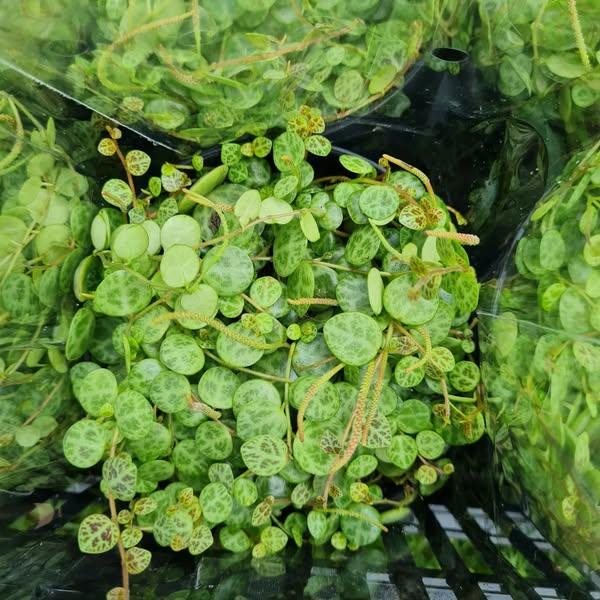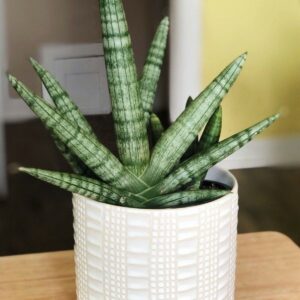✨🌿 Peperomia prostrata, also known as the String of Turtles
Peperomia prostrata, the String of Turtles, is a fascinating trailing plant with small, spherical leaves that resemble turtle shells. Indigenous to the Brazilian rainforests, it does well in warm, humid conditions and is frequently cultivated as a houseplant in terrariums, hanging baskets, or shelves. Plant collectors and indoor gardening aficionados adore it for its distinctive appearance, small size, and simple maintenance.
Overview of Botany
Peperomia prostrata is its scientific name.
Piperaceae is the family.
Common Names: Magic Marmer, String of Turtles
Brazil is the source.
Growing behavior: either a creeping or trailing plant
Size:
Height: 2-4 inches (5-10 cm)
The vine’s length: It may extend anywhere from 12 to 24 inches (30 to 60 cm) or more within.
🍃 Appearance
leaves:
Miniature, round to oval in shape, with complex silvery-white veins that mimic a turtle’s shell
The hue ranges from deep green to bluish-green.
A little succulent and solid to the touch
Form of Growth:
It’s perfect for terrariums or hanging baskets because of its trails or creeps.
Blossoms:
The blooms are little and unassuming, with prickly petals that pale in comparison to the foliage.
Sometimes blooms indoors, but not cultivated for flowers
☀️ Needs for Light
Inside:
Prefers bright, indirect light
Moderate light is acceptable, but growth will be slower.
Excessive exposure to direct sunlight can result in leaf burning and pattern discoloration.
Outside:
Ideal for filtered sunlight or shaded patios
Due to its lack of frost tolerance, it should only be used outside during specific times of the year in chilly regions.
Inadequate light results in leggy development and a disappearance of leaf patterns.
Humidity and temperature
Temperature:
Ideal temperature range: 18–26°C (65–78°F)
Needs to be maintained at a temperature greater than 15°C (59°F).
Vulnerable to abrupt temperature fluctuations and chilly breezes
Humidity:
Moderately high humidity (50% or more) is preferred.
flourishes in bathrooms, kitchens, or with a humidity tray
Although it can tolerate typical interior humidity levels, it may require more humidity throughout the dry months.
💧 Watering Procedure
Spring to Early Autumn (Active Growth):
Apply water to the soil when the top 1–2 inches seem dry.
Generally every 7–10 days, but the frequency changes depending on the humidity and temperature.
Avoid shock by using water at room temperature.
Winter (Dormancy or Slow Growth):
Water every two to three weeks, less often
To prevent root rot, keep the soil from becoming wet.
Tip: Because of its succulent-like leaves, which store moisture, water it less frequently than the average tropical plant.
🌱 Soil Conditions
Sort:
Needs a soil combination that is airy and drains well.
Perfect combination:
coco coir or a potting mix that is half peat-based
25% pumice or perlite
25% coarse sand or orchid bark for improved drainage
The pH range is between somewhat acidic and neutral (6.0–7.0).
Make sure the pots have enough drainage holes to avoid waterlogging.
🌾 Fertilization
Apply fertilizer during the growing season (spring and summer).
Apply a diluted balanced liquid houseplant fertilizer (half strength) every 4-6 weeks.
Refrain from fertilizing in the winter when plant growth slows.
Roots can be harmed by salt accumulation caused by excessive fertilization.
Maintenance and pruning
Trim gently to:
regulate the length of vines
Promote fuller growth
Get rid of any leaves that are dead or turning yellow.
For a fuller look, try pinching the tips to encourage branching.
🌿 Reproduction
Stem cuttings:
Cut healthy vine segments with many leaves.
Put in water or damp soil until roots form
Roots usually develop in 2–4 weeks.
Division:
May be separated during repotting, especially if the plant is dense
Because propagation is simple, plant lovers will enjoy it.
Common Issues
Overwatering: mushy leaves, root rot
Underwatering: Leaves wilt and fall off
Infections:
prone to spider mites, mealybugs, and fungus gnats
Neem oil, insecticidal soap, or physical removal should be used to address the problem early.
Leaf Fall: Typically brought on by excessive watering or exposure to cold
⚠️ Toxicity
Not harmful to people, dogs, or cats
It is a pet-friendly houseplant that is safe for families with dogs.
🎍 For Ornamental Purposes
Ideal for:
Hanging baskets
Wall-mounted flowerpots
Terrariums
Trailing shelf displays
tiny interior gardens
Its little leaves, which have a turtle shell pattern, give indoor settings texture and appeal.
✅ Conclusion
Peperomia prostrata, also known as String of Turtles, is a charming trailing succulent that requires little care and may be grown in a variety of indoor conditions. With the appropriate soil, moderate light, and careful watering, it will flourish and turn into a gorgeous, cascading statement piece in any house or workplace.
Office Plants, Succulents
String of Turtles Plant
₨599.00
String of Turtles Plant
Trailing vine with turtle-shell patterned leaves, offering unique charm and compact size for shelves or hanging planters.





Reviews
There are no reviews yet.